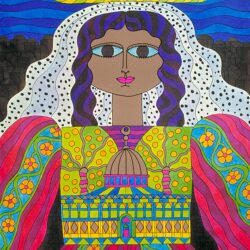5 Facts About Fashionable, Morning and Domestic Apparel in 18th Century France

In the 18th century those who could afford it, and who had enough leisure time, preferred to wear morning apparel which was always informal in character. Domestic apparel was only worn in the privacy of the home but which, in certain forms and in some milieus and epochs, occasionally also appeared outside the home. Here are 5 facts about fashionable, morning and domestic apparel in 18th century France
1. Ladies in negligé were portraited
At the end of the 17th century, in Western Europe, deshabillé is well-established as a term for informal clothing. At the time, French engravings present ladies of the high aristocracy in deshabillé, ranging from informal dresses worn outside the home to the so-called deshabillé negligé, which belong in the intimate sphere of the private residence.

Published prints of ladies in negligé, however, are anything but a self-evident phenomenon. Ladies of the high French aristocracy have their portraits painted in negligé. Commissioning a portrait engraving of oneself en negligé is a clear statement. It underscores own’s status and challenges the establishment at the same time. Being dressed in this way, which often goes hand-in-hand with the process of preparing oneself for the day has always been a privilege of the leisure class.
2. The deshabillé negligé is actually comfortable to wear
The deshabillé negligé of the late 17th century takes various forms, but all have the shared characteristic of being relatively comfortable to wear. Because there are no rigid stays under the loose-fitting outer garments, or only stays with a minimal amount of whalebone, garments of this kind offer considerable freedom of movement.

A good example is the portrait of the Duchess of Bouillon from 1695 where she wears loose fastened stays over a shirt, a petticoat, an opened long dressing gown, with a lace headdress and a pair of slippers as accessories. The loose character of the stays and the dressing gown guarantee greater freedom of movement and therefore greater comfort. This will remain a characteristic trait of negligé apparel.
3. Some forms of the deshabillé negligé become a part of the formal apparel


In the first quarter of the 18 century, two forms of the deshabillé negligé: the manteaux and the sacque dress, gradually assume a more formal character, becoming the robe à l’anglaise and the robe à la française. The wide sacque dress with loose pleats at both the front and the back, from the shoulder all the way to the hem, is half open to the hips, or completely open, revealing the skirt. This dress is initially not fastened at the waist, making it ideally suited as comfortable morning or house dresses.


4. The combination of skirts with a separate jacket became popular in the 18th century
In the 18th century, separate jackets, combined with skirts, are extremely popular in all social circles and across all of Europe. The fabrics and the finishing vary according to social standing and milieu. In about 1770, the combination of skirt and jacket becomes fashionable. Their deshabillé character nonetheless remaines unchanged. Depending on the nature of the jacket, it can either be tailored, or more commonly, loosely fitted. In France, the tailored jacket acquires the name of caraco or pierrot.


The caraco is no longer seen as something to be worn exclusively indoors. It is reported that this jacket is worn for morning strolls when it is still too early to ‘dress’. In this sense, the jacket remains morning apparel and deshabillé.

The status of the jacket and skirt changes in fashionable circles in the second half of the 18th century, from deshabillé négligé for indoors to deshabillé du matin which can also be worn outdoors. Other articles of clothing remain strictly for use inside the home. This was true for the peignoir or dressing gown that originates with the hairdressing cape, and which is closely associated with the morning toilet. Given that this ritual often has a social function in fashionable, wealthy milieus, during which guests are received, the apparel is responsive to fashion.
5. Popularity of printed fabric led to protests

Chintz, the multicoloured, hand-printed and hand-painted cotton fabrics from India have such enormous success in France in the latter 17th and early 18th centuries that the local silk, wool and linen manufacturers mount official protests. This leads to the prohibition of their import and use in France.

After 1750, when government policies on chintzes relax in France, local entrepreneurs and traders respond with the manufacture of local printed cottons and these fabrics become popular for the fashionable jacket-skirt combinations. Printed cottons are washable, and in an age when personal hygiene is becoming more important, this is not an insignificant factor. In addition to this characteristic, attractive prices and fashion appeal help win printed cottons a place in contemporary culture.
THIS TEXT IS BASED ON EXCERPTS FROM “COMFORTABLE AT HOME”, WRITTEN BY WIM MERTENS, PUBLISHED IN “LIVING FASHION WOMEN'S DAILY WEAR 1750 - 1950 FROM THE JACOBA DE JONGE COLLECTION”.


